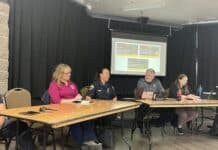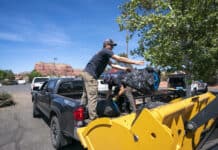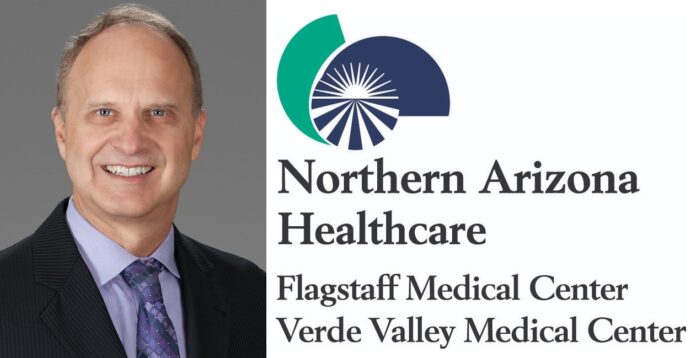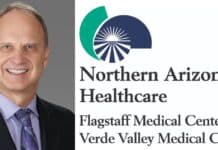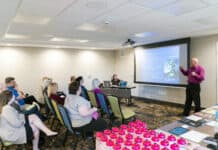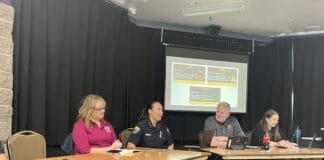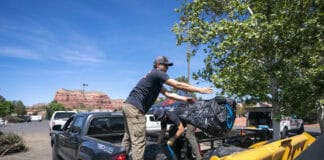Northern Arizona Healthcare CEO David Cheney answered questions during an in-depth interview in December.
Verde Valley Health Care Series
This is the third story in a series from an in-depth interview with new Northern Arizona Healthcare CEO David Cheney.
■ Can you speak about staffing shortages at the catheter lab at Verde Valley Medical Center?
Cheney: “We’re going to beef that up because we’re going to have an interventional cardiologist down here [at Verde Valley Medical Center]. We’re going to have to have more staff to run more hours down there. This is — the biggest hole in the Verde Valley here is cardiology, but we’re going to fix it, immediately. Electrophysiology is very different than your general cardiology, which is really different from your interventional cardiology.”
■ How are you working to keep ancillaries services going?
Ancillary services include radiology, home health care services, laboratory services, cardiac monitoring, hospice, rehab, private duty nursing, audiology, dialysis, orthotics and prosthetics, home infusion therapy, medical day care, pharmacies, physical therapy, occupational therapy, implants, massage therapy and ultrasonography.
Cheney: “In terms of attracting workers? We’re reaching out to all of the different trade schools and we’re trying to get new programs in Northern Arizona started.
“I haven’t talked with the community colleges yet, which is not good. I need to do that immediately because that’s where a lot of these kids are coming out of. I have talked to [Northern Arizona University] about working with the community colleges. I’ve developed a great relationship with the NAU president [José Luis Cruz Rivera]. I love the fact that he’s developing a medical school up there, because that’s going to help Northern Arizona tremendously because his program is going to be specifically pushing out young physicians that specifically want to work in rural medicine, rural medicine in Arizona and hopefully rural medicine in Northern Arizona. It’s going to be huge, but you have to be patient, because it’s going to be years and years for this thing to happen. But it will make a huge difference in Northern Arizona. From talking with him about what that looks like — can we be the teaching hospital? In that conversation, not just doctors but nurses and technicians as well.
“So we have to make sure that we have a plan for that. It’s not just one, right? You have to make sure you have connections with the schools in Phoenix and the schools up here, the schools everywhere. And then you have to attract those students.
“So I’m hopeful that’s not going to be a problem for us. Attracting people isn’t the problem. The salaries aren’t the problem. The problem is housing. How do we get them housing? That’s the problem.”
■ Can you talk about Flagstaff’s Proposition 480? What happens now?
Starting in 2021, Northern Arizona Healthcare planned a new hospital near Fort Tuthill County Park, which the hospital described as a “health care village,” on 172.6 acres of land NAH purchased over the last few years. The planned development will consist of a 1,265,950-square-foot medical center with up to 468 beds — replacing NAH’s current 317-bed Flagstaff hospital — approximately 315 housing units, 382,000 square feet of commercial space including three hotels, 250,000 square feet of research and development space and 30 acres of open space. The facility would cost $922.7 million to build, funded by NAH and through the sale of $450 million in private bonds. Though the rezoning request for the land was approved unanimously by the Flagstaff City Council, a referendum known as Flagstaff Proposition 480 overturned the council vote in November, effectively terminating the project.
Cheney: “We have several options to work with that land. We haven’t made that decision yet. Officially, we don’t know. Officially, I don’t know where the new hospital is going to be.
“The community needs a lot of time to heal, not just Flagstaff but down here as well, and I need to get out and get people educated.
“I met with the mayor of Jerome, the city manager and a city councilman. The first thing they said to me was, ‘We’re really glad that that thing up there failed, honestly.’”
“I said, ‘Why?’
“They said, ‘Because what we heard was you were going to move everything out of the Verde Valley, move it up to Flagstaff and shut down the hospital [Verde Valley Medical Center].’
“I said, ‘That couldn’t possibly be further from the truth.’”
■ That is the narrative in the community. What’s the official stance on that?
Cheney: “The official stance is: There are going to be no services that are moving from Verde Valley or Sedona. Zero. We’re going to build the medical services, both ambulatory and inpatient, in Sedona and Verde Valley. There will be no services that move out of Verde Valley or Sedona to Flagstaff. Zero.”
■ NAH is not asking for money from taxpayers, government money or a bond from taxpayers. NAH appears to be raising the money independently. If NAH has nearly a billion dollars for the new facility, is that because NAH has nearly a billion dollars to spend?
Cheney: “Exactly right, and more specifically, over decades, NAH has saved about $400 million in cash, and then they were going to build the bond market for another $400 million. None of that is tax money.
“We had one person in a community forum say, ‘Well, those bonds, that’s are our taxes.
“I said, ‘Let’s talk after, I didn’t know what you’re confusing with, but this has absolutely nothing to do with taxes.’”
■ So if someone wants to buy an NAH bond, that’s a private person’s investment?
Cheney: “Yeah, so that’s how it’s going to get funded.
“There was no burden on the taxpayers at all. We didn’t do a good enough job of saying, ‘What’s the tax benefit?’ — in other words, the amount of economic growth that would come with bringing a new hospital and these new things around it would way offset the zero it was going to cost them in taxes.
“In other words, it would have been a positive thing for them, economically, if that’s what they were worried about, but they weren’t going to pay taxes on it.
“Somebody can get specific and say, ‘Well, that’s not true. We have to put a fire station there — our taxes paid for that.’
“That’s true, but we were going to pay for half of that fire station, which is unheard of in most cities.
“Here’s the deeper discussion: The city [of Flagstaff] is going to have to put that fire station there anyway, because it’s not a fire station just to serve the hospital, it serves that growing area down there.
“The thing that they needed help with was [that] it’s going to need a ladder truck that they don’t need for everybody, but that’s what we were paying for. So going forward, so yes, if they [the city of Flagstaff] add a new fire station over the next 10 years, their taxes are going to go up.”
■ There are some infrastructure things that the hospital was going to pay for, too, right?
Cheney: “We’ve never done a project like that; most cities that want a hospital in our town say, ‘We’ll do all the infrastructure stuff, you just build the hospital.’”
Referring to the Flagstaff City Council, Cheney said, “They said, ‘We don’t have the money for that. So if you want to build the hospital there, you’re going to have to pay for the roadways, you’re going to have to pay for half of the fire station.’
“And we agreed to do that for tens of millions of dollars, because that’s how badly we needed a hospital.”
■ Legally and politically, there’s nothing really to stop NAH from going back to council and asking them to approve this again, right?
Cheney: “You have to wait one year.”
■ Is that an option?
Cheney: “Officially, everything is on the table.”
■ You had a unanimous Flagstaff City Council vote to approve the rezoning.
Cheney: “I don’t think the council would support allowing me to move forward, and I think the community was pretty vocal about it.”
■ Would you go back in a year and just say we just want the hospital, and not the “health care village”?
Cheney: “We really do want to keep everything open. That is an option — it could be one of my least favorite, because it opens up the wound again. That piece of land represents an open wound that will take years for it to heal up. I don’t want to open that again.”


